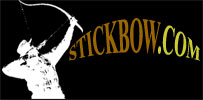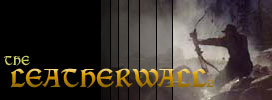| From: Zbone
|
|
|
|
|
|
|
| Date: 30-Jul-22 |
|
From the other thread was looking at George's link to: https://echoarchery.com/collections/all... And first I'd ever heard of Cherry Bark Backing... I'm like, hmmmm, how does that work? I did a search here on this site, "Cherry Bark", nothing found...
|
|
| From: fdp
|
|
|
|
|
|
|
| Date: 30-Jul-22 |
|
You peel the bark off the tree in long strips and glue it on like a rawhide or similar backing.
|
|
| From: Mechanic
|
|
|
|
|
|
|
| Date: 30-Jul-22 |
|
Strips cut crosswise not lengthwise from the tree. Supposedly cherry bark is one of the the strongest out there.
|
|
| From: Rik Davis
|
|
|
|
|
|
|
| Date: 30-Jul-22 |
|
One of the 1996 issues of Instinctive Archer has a nice article on cherry bark backing. Sorry I cannot tell you the actual issue.
|
|
| From: fdp
|
|
|
|
|
|
|
| Date: 30-Jul-22 |
|
There was some good information on it on the Primitive Archer site as well.
|
|
| From: Jeff Durnell
|
|
|
|
|
|
|
| Date: 31-Jul-22 |
|
Peel it off around the tree, the bigger diameter the tree the better. But it can be spliced if the pieces arent long enough. Birch works too. Cherry looks awesome on yew bows.
|
|
| From: B.T.
|
|
|
|
|
|
|
| Date: 31-Jul-22 |
|
It looks really good, I doubt it adds much else?
|
|
| From: Jim Davis
|
|
|
|
|
|
|
| Date: 31-Jul-22 |
|
B.T. speaks truth. If the back ring of a wood bow is intact, it will be 3 times as strong in tension as the belly is in compression.
Adding a stretchy backing such as sinew, will change performance. Cherry or bamboo, not much if at all.
|
|
| From: Jeff Durnell
|
|
|
|
|
|
|
| Date: 31-Jul-22 |
|
Cherry bark backing adds protection to a relatively soft yew selfbow back. It also works at least as good as rawhide for suspect bow backs of other woods where splinters might lift due to pin knots, grain vagaries, etc. It's a useful backing, tough, and looks good.
|
|
| From: Runner
|
|
|
|
|
|
|
| Date: 01-Aug-22 |
|
Bamboo doesn't add much if anything? It most certainly can.
|
|
| From: chamookman
|
|
|
|
|
|
|
| Date: 01-Aug-22 |
|
My first Self Bow, was a Cherry Bark backed Black Cherry. Beautiful Bow. John Strunk via Snail Mail got Me thru the prosess. do a search on Him, should be a wealth of information. Bob
|
|
| From: Altitude Sickness
|
|
|
|
|
|
|
| Date: 01-Aug-22 |
|
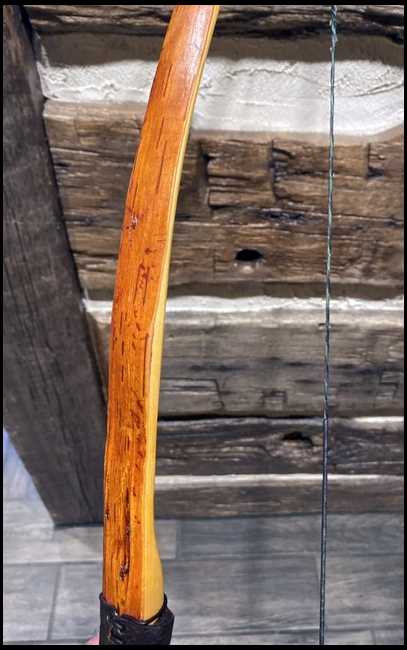
This is a Black Cherry bow I made for my Grandson. I think it was about 46” and 15 pounds. with Silver/White Birch bark backing. I found a large diameter birch and cut the backing strips around the circumference. Not length wise, because the fibers of the inner bark runs around the tree not up and down the tree. I peeled the outer paper or white bark off until the heavy brown bark was exposed. The consistency of other birch products like canoes. It added protection but I don’t think any performance.
|
|
| From: Altitude Sickness
|
|
|
|
|
|
|
| Date: 01-Aug-22 |
|
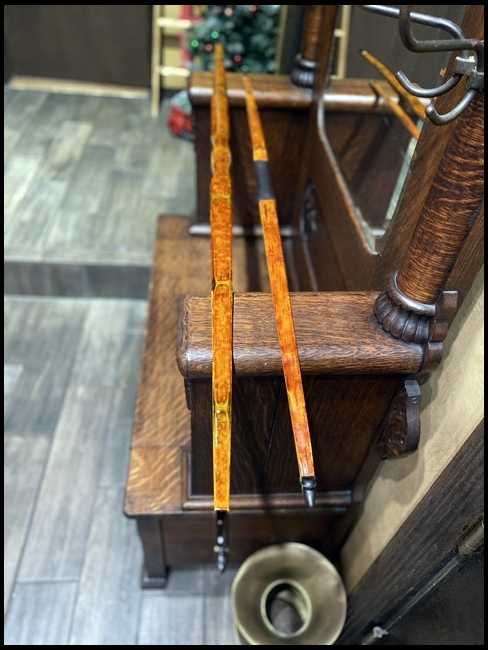
My grandsons Black Cherry and Birch bow on the right. The Black Cherry was from a very old tree of mine that had a large piece break off and needed to be taken down. I made a lot of things from that tree. Coffee Tables, bows , war club
|
|
|
|
| From: Mechanic
|
|
|
|
|
|
|
| Date: 01-Aug-22 |
|
1996 issue of instinctive archer magazine, page 70. Message me if you want the copy of the article.
|
|
|
|
| From: Jim Davis
|
|
|
|
|
|
|
| Date: 01-Aug-22 |
|
If you want to deal in facts, research wood strength and you will find that wood is 3 to 4 times stronger in tension than compression.
The bottom line is, if you have an intact growth ring on the back, it will be the belly that fails first. (Cherry is an exception). Strengthening the back does nothing to change that fact.
Backings are helpful with compromised backs. Otherwise, they are just decorative. This is not just an opinion.
Put in the research and you'll believe it.
|
|
| From: Runner
|
|
|
|
|
|
|
| Date: 01-Aug-22 |
|
How many bamboo or hickory etc. backed bows have you made Jim?
|
|
| From: Jeff Durnell
|
|
|
|
|
|
|
| Date: 01-Aug-22 |
|
Absolutely not true as stated, Jim.
|
|
| From: Jim Davis
|
|
|
|
|
|
|
| Date: 01-Aug-22 |
|
Neither of you has ever researched wood strength, right?
BTW, I have made hickory backed bows, and they worked fine. But the bows were backed because the self back was violated. They would not have worked without the backing.
|
|
| From: Jeff Durnell
|
|
|
|
|
|
|
| Date: 01-Aug-22 |
|
Jim, don't overreach. Don't incite me. I've never discussed anything on a message board with which I don't have adequate personal experience, and I didn't start doing so today.
|
|
| From: Jim Davis
|
|
|
|
|
|
|
| Date: 01-Aug-22 |
|
Jeff, perhaps we have a failure to communicate? I am talking about tension and compression parallel to the grain. I have found that info posted on Quora and other quick and dirty sources sometimes does not specify grain direction when considering strength.
All the legitimate testing facilities I have found over the last 25 years of looking, such as the Forest Products Laboratories (after noting the difficulty of testing tension strength) conclude that wood is several times stronger in tension parallel to the grain than in compression in that direction.
This is not new or obscure information.
A backing strip can make a bow stronger, but it does it by adding thickness, not by being a stronger material. (Except in woods such as cherry, that are weak in tension. [Noted in earlier post.])
|
|
| From: Runner
|
|
|
|
|
|
|
| Date: 01-Aug-22 |
|
Yes we have, Jim. Various woods and bamboo species have different strength and stiffness so it's not a generic number. You are confusing whether a bow breaks or not as some sort of final goal.
I think your "every bow should just be a simple pyramid" thought has stifled your knowledge base.
|
|
| From: Jim Davis
|
|
|
|
|
|
|
| Date: 01-Aug-22 |
|
Runner, I will admit to being a minimalist. Wood bows, being wood, are hard to compare to each other, because wood is not homogenous. Two bows made to the exact dimensions of wood from the same tree can differ in performance.
As far as a stifled knowledge base, it is in fact my knowledge base that leads me to feel that any performance improvement over a pyramid design is not worth the effort--unless the journey is more important than the destination. For me it's not. But it's a very informed conclusion. Not the result of ignorance.
A bow that launches an arrow at a given speed, will not launch it faster if the limb thickness is reduced and a backing of the same thickness is added, whether hickory or bamboo or whatever wood. Yew might be an exception, because its sapwood back is more elastic and a backing might be less elastic, putting more strain on the belly.
|
|
| From: Jeff Durnell
|
|
|
|
|
|
|
| Date: 01-Aug-22 |
|
We should never be satisfied with or overly sure of our current knowledge base, but incessantly work to uncover and exploit any size inadequacy and use those discoveries to spawn focused inward inquisition... first.
|
|
| From: Runner
|
|
|
|
|
|
|
| Date: 01-Aug-22 |
|
"A bow that launches an arrow at a given speed, will not launch it faster if the limb thickness is reduced and a backing of the same thickness is added, whether hickory or bamboo or whatever wood. Yew might be an exception, because its sapwood back is more elastic and a backing might be less elastic, putting more strain on the belly."
You've almost got it. There are exceptions, several of them. And that's exactly the point.
|
|
| From: Runner
|
|
|
|
|
|
|
| Date: 01-Aug-22 |
|
Here's an old back in the day quote when backed bows were at their peak.
"Turning to Jim Deed's catalog, he begins by supplying the advantages of giant timber bamboo [I'm not sure what he means here]. "For many customers, in most cases amateur bow makers, the power of yew, osage, black locust, lemonwood, and other materials has doubled or trebled with the application of bamboo backings. A 30# yew up to 100# is the record.
During the past four years many thousands of pieces of this material have been used with a miniumum of complaints and an ever increasing demand for bamboo.
Fully matured and seasoned bamboo has the least give or stretch of any wood used for bows or backings. A given thickness of bamboo adds more power than the same thickness of wood, silk, sinew, or rawhide. Bamboo takes little set, if any. It has no appreciable "let-down" because of weather."
|
|
| From: Jim Davis
|
|
|
|
|
|
|
| Date: 01-Aug-22 |
|
A factor to consider is that wood (can't say for bamboo because I have not seen test results for it) only stretches 1% or less before it breaks (the yield portion of the strain). Most of the elasticity in most woods is in the compression side. So, a stronger backing will mostly make the belly bear a larger part of the strain. If it's already tillered to its limit, it will chrysal.
I don't know when Jim Deed was dealing in bamboo, but there was a lot of hyperbole in advertising in the past (present too for that matter.)
|
|
| From: B.T.
|
|
|
|
|
|
|
| Date: 01-Aug-22 |
|
|
|
| From: Runner
|
|
|
|
|
|
|
| Date: 01-Aug-22 |
|
You're getting there, Jim. :)
Backed bows perform better any way you want to twist it. YOU just don't think the benefits are any good for you.
|
|
| From: Altitude Sickness
|
|
|
|
|
|
|
| Date: 02-Aug-22 |
|
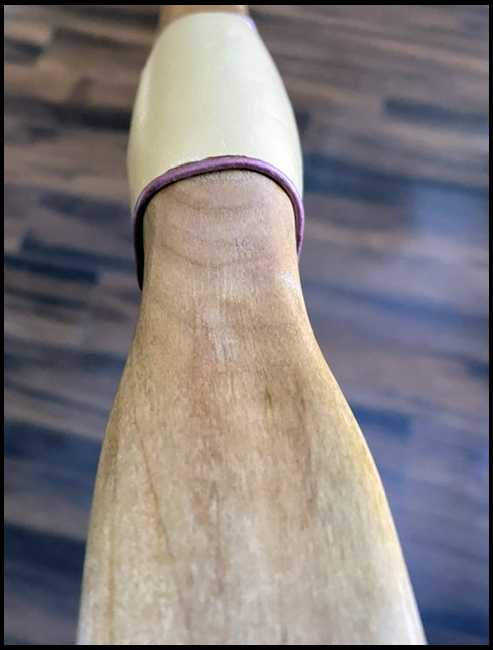
Here is a black cherry bow that I made from an old tree. I backed it with bamboo and it improved performance noticeably. Reading how others built such bows I did take more off the bamboo sides so it wouldn’t over power the cherry. It doesn’t perform like a bamboo backed osage bow. but it’s wood that grows on my property.
|
|
|
|
| From: Altitude Sickness
|
|
|
|
|
|
|
| Date: 02-Aug-22 |
|
Also I removed a lot of wood to keep the weight in the mid 40s after adding the bamboo so the weight is close to the original of the cherry bow. And it improved cast noticeably
|
|
| From: tecum-tha
|

|
|

|
|
|
|
| Date: 03-Aug-22 |
|
What a surprise. Put something strong in compression on the belly side and something strong in tension on the back. Make the compression wood side (mostly heavier wood) as thin as possible...
|
|
If you have already registered, please sign in now
For new registrations Click Here
|
|
|
|
